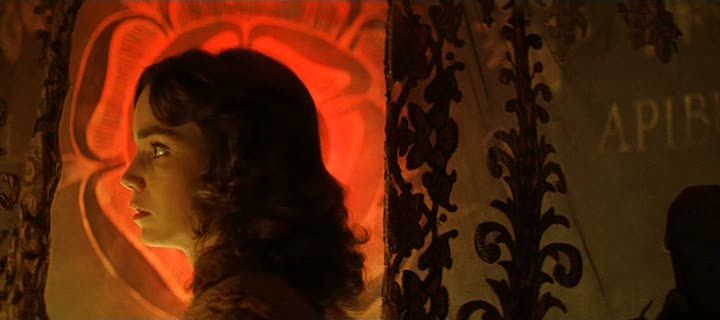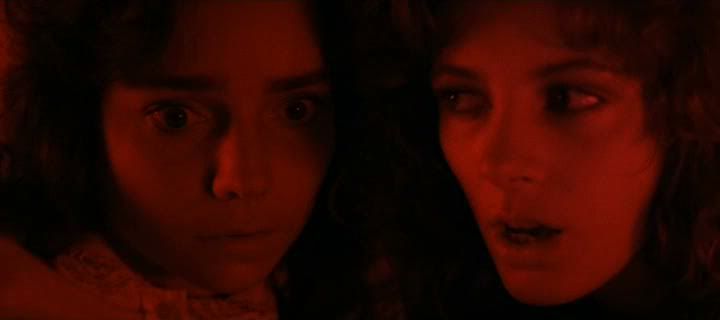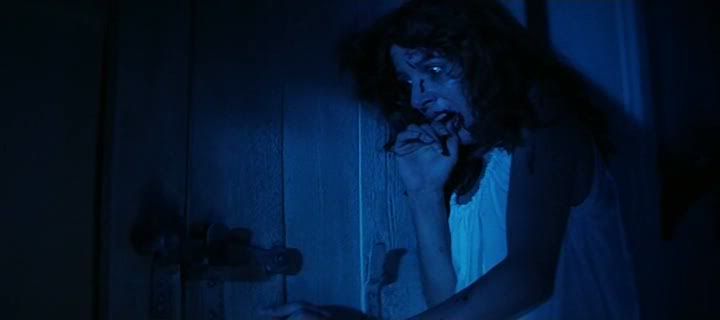
Dario Argento's Suspiria is a horror film based almost entirely around mood and the slow escalation of tension through music and garish color schemes. The film's concrete horrors — a sequence of murders and creepy occurrences at a German ballet school — don't arouse nearly as much terror or suspense as Argento's habit of filming nearly every scene as though something indescribably awful were lurking just out of sight. The film's design is lavish and ornate, and rather than finding terror in shadows and dark tones, Argento bathes these scenes in bright, saturated colors. The ballet school where American student Suzy (Jessica Harper) goes to study is a high Gothic palace with hallways decorated in bright red, its wild architecture topped only by the geometric lunacy of the apartment building where doomed ballet student Pat (Eva Axén) flees to in the opening scenes of the film.
The film's opening in general is a masterpiece of slow-building horror. Suzy arrives at an airport, and as she walks towards the doors leading outside, Argento immediately begins building up the suspense, well before there's anything to get the least bit scared about. Suzy seems hesitant and timid, somewhat rattled already; Harper makes good use, throughout the film, of her big brown eyes, which are often widened in anxiety, shifting back and forth, her pupils small and skittish, seeming lost in the broad whites surrounding them. Argento alternates closeups on Suzy's fragile face with shots of the airport doors. The closeups are silent, but the door shots are accompanied by the sinister but gorgeous chiming tones of the score, by Italian prog rock band Goblin, whose eerie chanting and chugging rock set the tone of the film. When Suzy leaves the airport, into a dark, rainy, windy night, the doors slide shut behind her with an air of finality that suggests a break with normalcy, the terror to come foreshadowed by the gloomy, stormy night that engulfs her. Her cab ride to the ballet school, with Goblin's pulsing main theme returning on the soundtrack, is equally chilling. It's only in the subsequent scenes, following Pat as she flees from the school just as Suzy arrives, that these premonitions of terror turn out to be warranted. Pat escapes the school and shows up at a friend's apartment, the very design of which, with its colorful patterns and high, vaulted ceilings, establishes that something strange is going to happen here.


Argento is excellent at using lighting and design to create the film's unsettling tone. He frequently focuses on closeups of the film's women — Pat during the opening, Suzy and her new friend Sara (Stefania Casini) later on — as they confront the strange events surrounding them. Faces mean a lot to Argento, faces in various contortions of terror and uncertainty, faces with eyes widened in fear and mouths gasping breathlessly. Agento films Suzy with colored lights washing across her face, especially hovering around her eyes, emphasizing her deer-in-headlights stare. It's obvious that he likes exploring the vulnerability of these women: Suzy seems afraid even before she arrives at the school, in the opening scenes at the airport, as though she's anticipating the rest of the film. The faces of the women, bathed in various colored lights, telegraph the film's mostly abstract horrors, because despite the murders that occur throughout the film, Argento seems more concerned with capturing the pervasive, undirected sense of dread and strangeness that exists within this film, taking hold of these women and slowly driving them to madness.
The film is thus a study in feminine vulnerability and fear. Argento allows the tension to build and build. At one point, he zooms in for a closeup on Suzy and Sara, their heads pressed together in conspiratorial whispering, the whole image filtered red. The women are talking about the odd snoring of one of their teachers, sleeping nearby, her silhouette cast against a curtain, black in the red room. It would be innocuous or even comical, except that Argento pitches it towards unhinged terror, the two women looking terrified, working themselves into a state of weird excitation over the raspy snoring of an old woman.


The impact of the film's music in creating this state of irrational anxiety can't be overstated, either. Goblin's music is as integral to Suspiria as the stylized imagery, despite the fact that the band — who had previously scored Argento's Deep Red — composed the music before seeing the film. The music just fits perfectly, becoming inseparable from the bright, creepy images. The tinkling chimes and bells of the main theme, which reappears frequently, is often joined by whispery chanting and moaning, ghastly voices that seem to be communicating with the film's characters. The word "witch" is whispered in the music long before any of the characters actually utter it, which makes it seem like the music is emanating from a kind of demon band who are foreshadowing the film's plot with their haunting music. In one scene where Sara is reacting to some unsettling sounds in the darkness, the sounds she's hearing blend into the sighs and thuds of the music, so that it's not clear if she's reacting to an actual noise in the room, or to the music that's creeping in from outside the diegesis.
That the film eventually provides a supernatural explanation for all these odd occurrences and acts of violence does little to resolve anything. Argento is so good at whipping up an atmosphere of edgy, all-encompassing dread that harnessing this aimless terror to concrete causes is somehow unconvincing. The film never seems to be actually about a coven of evil witches who run a ballet school, even though that's a fair description of its plot. Suspiria is rarely constrained or dominated by its plot; at times it seems almost plotless, more of a mood than a story. That's what makes it so affecting, so unsettling. In typical horror movie fashion, it wraps everything up in the end, driving the protagonist towards a confrontation with the evil lurking within the school. But the operatic excesses and flashy violence of this denouement do nothing to ease the sense of unmotivated fear roused by the union of Argento's visuals and Goblin's music. In the final scene, Suzy grins with relief as she rushes out into the rain, mirroring the stormy opening scenes, but the unease generated by the film lingers well past its supposedly happy resolution.








0Awesome Comments!